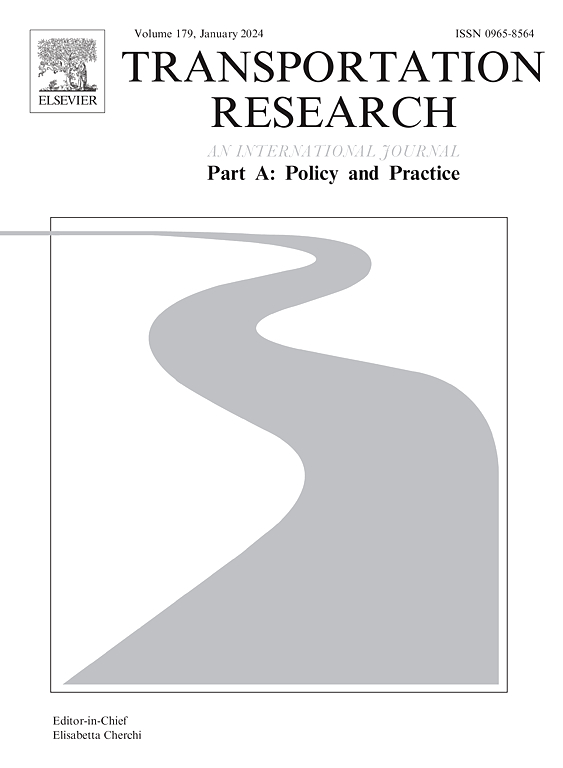Potential short- to long-term impacts of on-demand urban air mobility on transportation demand in North America
IF 6.3
1区 工程技术
Q1 ECONOMICS
Transportation Research Part A-Policy and Practice
Pub Date : 2024-10-29
DOI:10.1016/j.tra.2024.104288
引用次数: 0
Abstract
This study applies an agent-based approach to investigate the potential individual-level demand for and system-wide impacts of Urban Air Mobility (UAM) in the short- to long-term, in two real U.S. metropolitan areas. The UAM service we envision in this research provides mobility to on-demand requests from one vertiport to another. The investigations consider the existing electric vertical take-off and landing (eVTOL) aircraft models (assuming they are piloted) and vertiport designs, while accounting for the uncertainties in (i) service attributes (e.g., time saving and service price), and (ii) demand characteristics (e.g., perceived waiting time in various conditions). Towards this goal, the state-of-the-art agent-based simulation platform SimMobility is expanded in this research with new modules required for realistic simulation of the demand, supply, and demand–supply interactions. The expanded platform adopts a high-fidelity model system with: (i) a behaviorally sound demand model to mimic the switching behavior from current non-UAM mode to UAM and to capture the individuals’ willingness to pay and plan-action dynamics in decision-making; (ii) a detailed operation model to account for not only the integration of ground and aerial transportation but also fleet rebalancing and the intra-vertiport state dynamics such as charging, gate availability, taxiing, pre-landing hovering (as a result of capacity limitations), etc.; (iii) a demand-driven vertiport placement and capacity generation module. The results show that the UAM market is expected to start narrow (0.187 % to 0.197 % of all trips) and remain niche in the long term (1.45 % to 1.81 % of all trips) for both cities. In addition, the service is expected to increase mobility inequality, even in the long term. The potential UAM users turned out to be primarily high-income in all scenarios (e.g., 46.9 % to 59.2 % in the long term). Moreover, car-oriented individuals are identified as the main users – not only are most UAM trips expected to emerge from drive-alone trips (84.7 % to 92.8 % at launch), but also drive-alone is expected to be the most preferred access/egress mode (78.4 % to 83.6 % share among all UAM trips at launch). Notably, short-range UAM trips (i.e., flight distance below 40 km) constitute the majority of the UAM potential demand (94.6 % in the long-term scenario).
按需城市空中交通对北美交通需求的潜在短期至长期影响
本研究采用基于代理的方法,在两个真实的美国大都市地区调查个人层面对城市空中交通(UAM)的潜在需求和对整个系统的短期至长期影响。我们在这项研究中设想的城市空中交通(UAM)服务可按需提供从一个港口到另一个港口的交通服务。研究考虑了现有的电动垂直起降(eVTOL)飞机模型(假定其为驾驶型)和机场设计,同时考虑了以下方面的不确定性:(i) 服务属性(如节省时间和服务价格);(ii) 需求特征(如各种条件下的感知等待时间)。为实现这一目标,本研究对最先进的基于代理的模拟平台 SimMobility 进行了扩展,增加了现实模拟需求、供应和供需互动所需的新模块。扩展后的平台采用了高保真模型系统,包括(i) 一个行为合理的需求模型,以模拟从当前非 UAM 模式到 UAM 模式的转换行为,并捕捉个人在决策中的支付意愿和计划行动动态;(ii) 一个详细的运营模型,不仅考虑到地面和空中运输的整合,还考虑到机队再平衡和垂直港内状态动态,如充电、登机口可用性、滑行、着陆前悬停(由于容量限制)等;(iii) 一个需求驱动的垂直港布局和容量生成模块。研究结果表明,在这两个城市,预计 UAM 市场起步较窄(占总出行量的 0.187% 至 0.197%),并将长期保持小众市场地位(占总出行量的 1.45% 至 1.81%)。此外,即使从长远来看,该服务也会加剧流动性的不平等。在所有方案中,UAM 的潜在用户主要是高收入人群(例如,长期为 46.9% 至 59.2%)。此外,以汽车为导向的个人被确定为主要用户--不仅大多数 UAM 旅行预计将来自自驾车旅行(启动时占 84.7% 至 92.8%),而且自驾车旅行预计将成为最受欢迎的出入口模式(启动时在所有 UAM 旅行中占 78.4% 至 83.6%)。值得注意的是,短程 UAM 旅行(即飞行距离低于 40 公里)占 UAM 潜在需求的大部分(长期情景中占 94.6%)。
本文章由计算机程序翻译,如有差异,请以英文原文为准。
求助全文
约1分钟内获得全文
求助全文
来源期刊
CiteScore
13.20
自引率
7.80%
发文量
257
审稿时长
9.8 months
期刊介绍:
Transportation Research: Part A contains papers of general interest in all passenger and freight transportation modes: policy analysis, formulation and evaluation; planning; interaction with the political, socioeconomic and physical environment; design, management and evaluation of transportation systems. Topics are approached from any discipline or perspective: economics, engineering, sociology, psychology, etc. Case studies, survey and expository papers are included, as are articles which contribute to unification of the field, or to an understanding of the comparative aspects of different systems. Papers which assess the scope for technological innovation within a social or political framework are also published. The journal is international, and places equal emphasis on the problems of industrialized and non-industrialized regions.
Part A''s aims and scope are complementary to Transportation Research Part B: Methodological, Part C: Emerging Technologies and Part D: Transport and Environment. Part E: Logistics and Transportation Review. Part F: Traffic Psychology and Behaviour. The complete set forms the most cohesive and comprehensive reference of current research in transportation science.

 求助内容:
求助内容: 应助结果提醒方式:
应助结果提醒方式:


